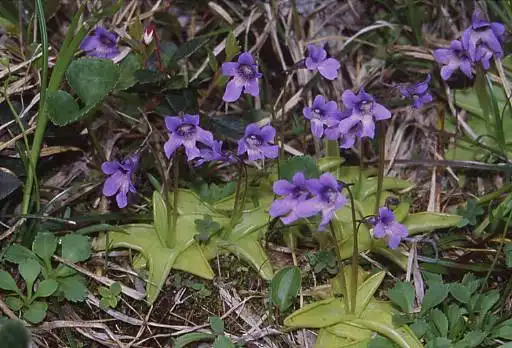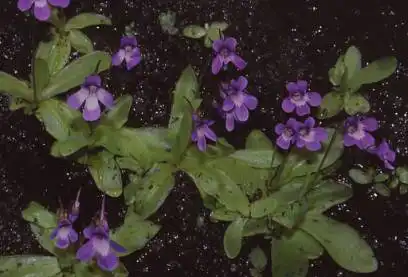Pinguicula macroceras
TaxonomyPermalink
- Family: Lentibulariaceae
- Genus: Pinguicula
- Name: Pinguicula macroceras
- Sub-classification (Casper): link
- Publication: By Link in Sprengel, Schrader et Link, Jahrb. Gewächskd. I (3) 54 (1820)
Description (in publication)Permalink
Perennis. Rhizoma simplex breve radicibus adventitiis numerosis filiformibus. Folia 3 - 8 radicalia rosulata integerrima obovata vel oblonga margine plus minusve involuta superne glandulis sessilibus stipitatisque +/- dense vestita 20 - 55 mm longa 7 - 18 mm lata virentia. Hibernacula. Pedicelli 1 - 3 vel plures erecti glandulisstipitatis disperse obsiti (25) 40 - 150 (210) mm alti uniflori. Flores magni (12) 18 - 27 (30) mm longi (calcari incluso). Calyx bilabiatus extus glandulis stipitatis obsitus; labium superum profunde trilaciniatum laciniis conspicuis duplo vel triplo longioribus quam latis triangulo-acutis vel obtuso-ligulatis basin versus non angustatis; labium inferum bipartitum laciniis lanceolatis usque ad 1/2 longitudinis connatis divergentibus. Corolla bilabiata purpureo-caerulea vel rosea vel raro albescens extus glandulis stipitatis singularibus obsita; labium superum bilobum lobis ligulato-obtusis; labium inferum multo longius trilobum lobis subobovatis interse plus minusve tegentibus. Tubus late infundibuliformis brevis intus pilosus pilis albidis longis cylindricis capitatis. Calcar cylindraceum rectum (1) 6 - 9 (11) mm longum dimidiam partem tubi limbique corollae subaequans. Pollen (5) 6 - 7 (8) - colporatum. Capsula ovoida calycem superans. Semina scobiformia.
Chromosomata ignota.
Origin and HistoryPermalink
Location / MapPermalink
HabitatPermalink
Introduction to HorticulturePermalink
Growth and PropagationPermalink
North hemisphere, France near Paris, in a garden - see the map
Life CyclePermalink
In spring, the cycle begins by the opening of the winter buds and the production of the first carnivorous leaves. The first leaves are followed by the flowers in summer. New carnivorous leaves are produced during all the season. Near autumn, or earlier, if your conditions are not optimal, the next hibernacula is revealed in the centre of the rosette. Then leaf production stops and the old leaves decay slowly. The plant (reduced now to a small hibernacula) is ready for winter and for the next cycle.
MediaPermalink
I use a media composed of sphagnum peat 50%, 10% vermiculite, 5% fine sand, 35% pouzzolane (volcanic lava).
PotPermalink
Big plastic box.
CultivationPermalink
The long term cultivation of temperate Pinguicula is difficult : If the summer growing conditions are not optimal, the plants will form very weak hibernacula which easily rot.
Optimal summer growing conditions are: good air humidity, cool temperature and UV lights.
I grow my plants in my garden all the year with a good amount of direct sun.
PropagationPermalink
By seeds or using the gemmae produced around winter hibernacula.
PicturesPermalink
|
Pinguicula macroceras in culture. From the Sugi river in the Hayade valley area, Japan. Photo : Eric Partrat - April 2005 - |
Pinguicula macroceras in culture. From the Sugi river in the Hayade valley area, Japan. Photo : Eric Partrat - April 2005 - |
|
Pinguicula macroceras in culture. From the Sugi river in the Hayade valley area, Japan. Photo : Eric Partrat - April 2005 - |
Pinguicula macroceras in culture. From the Sugi river in the Hayade valley area, Japan. Photo : Eric Partrat - April 2005 - |
|
If you want to see the habitat of Pinguicula macroceras from Hayade, follow the link. |
|
|
Pinguicula macroceras (growing at an altitude of ca. 1,700m, Mt. Zao, Yamagata Prefecture, Northern Japan) Photo : Prof. Kondo and Hiro Shimai |
Pinguicula macroceras (growing at an altitude of ca. 800m, Okunohira-dani Gorge, Mie Prefecture, Western Japan) Photo : Prof. Kondo and Hiro Shimai |
.webp)
.webp)
.webp)
.webp)

